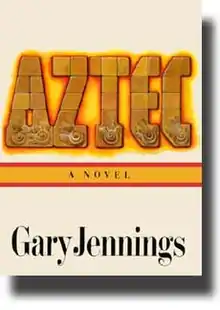 First edition cover | |
| Author | Gary Jennings |
|---|---|
| Country | United States |
| Language | English |
| Genre | Historical fiction |
| Publisher | Atheneum |
Publication date | 1980 |
| Media type | Print (hardbound) |
| Pages | 754 |
| ISBN | 0-689-11045-6 |
| OCLC | 6881009 |
| 813/.54 19 | |
| LC Class | PS3560.E518 A99 1980 |
| Followed by | Aztec Autumn |
Aztec is a 1980 historical fiction novel by American author Gary Jennings. It is the first of two novels Jennings wrote in the Aztec series, followed by Aztec Autumn. The remaining four novels (Aztec Blood, 2002; Aztec Rage, 2006; Aztec Fire, 2008; Aztec Revenge, 2012) were written by other authors after Jennings died in 1999.
Summary
The book is written as a series of letters from the Bishop of the See of New Spain to King Carlos of Spain, containing a transcribed biography of Mixtli (full name Chicóme-Xochitl Tliléctic Mixtli, "Seven Flower Dark Cloud", in Nahuatl), an elderly Aztec man, by Spanish Catholic monks during the 16th century.
The novel portrays the entirety of the life of Mixtli-Dark Cloud, who is asked by Bishop Juan de Zumárraga to tell about his life, since King Carlos I of Spain (Charles V, Holy Roman Emperor) wants a chronicle of what Aztecs were like. Born to ordinary parents and afflicted with keratoconus, Mixtli nonetheless rises quickly through the hierarchy of Mexican society, becoming a scribe, a wealthy trader, a renowned warrior, and eventually a lord of Tenochtitlan, and a highly respected councilor to Moctezuma II. The novel chronicles Mixtli's many adventures, which take him through all of the Aztec Empire ("The One World") and beyond. The 'composer' of the novel, Bishop Zumárraga, is often commented upon by the narrator, who notes when the Bishop arrives to hear generally lurid details of human sacrifice and sexual impropriety, and often leaves just as quickly in disgust. The Bishop's introductions to the various chapters of the chronicle often express his loathing for Mixtli and his weariness with recording what he considers to be the biography of a heathen and a sinner.
Plot
Mixtli is born on the Island of Xaltocan in the year 1466, to a stonemason father, a rather strict mother and an older sister named Tzitzitlini. He recalls witnessing a human sacrifice at the age of four. Mixtli makes friends with two local boys named Tlati and Chimali (with the paths of Chimali and Mixtli being tied together for a large part of Mixtli's life largely for worse). On his "naming day" at the age of 7, Mixtli is taken to Tenochtitlan by his father for a delivery of limestone as well as to see the dedication of the sunstone in Tenochtitlan's main plaza, this being Mixtli's first trip off the island (also in lieu of a birthday party). In Tenochtitlan's market, Mixtli and his father encounter a tiny old man, with gnarled hands, missing teeth and "cacao brown" skin (Secretly the Uey-tlatoani of Texcoco, Nezahuapili, who becomes a fixture in Mixtli's life, appearing out of nowhere on multiple occasions). Later, the pair encounter the old man yet again in a zoo in Tenochtitlan's main plaza. He offers to show Mixtli the "human animals" (albinos and people with deformities) kept at the far end of the zoo. Upon exiting the zoo; Mixtli, his father, and the old man watch the dedication of the sunstone, which is done with multiple sacrifices.
Upon arriving home, Mixtli finds his vision diminishing (implied to be due to keratoconus). He laments the loss of his vision, and fantasizes about travelling to the lands of the Maya, and having his vision restored by one of their renowned physicians. He also begins to harbor the secret ambition of becoming a "word knower".
Historical accuracy
The novel faithfully recreates a great deal of historical geographic places and history, particularly that involving the Spanish conquest of the Aztec empire in an expedition led by Hernán Cortés. Jennings, through Dark Cloud, presents generally accurate portrayals of the events surrounding a number of actual historical figures, their names usually rendered in traditional Nahuatl. This includes descriptions of many rulers ("Revered Speakers") of many civilizations, such as Ahuizotl and Moctezuma II of the Mexíca, Nezahualpili of the Acolhua or Patzínca of the Totonac, La Malinche (rendered Cé-Malinali, "One Grass" in Nahuatl, and later self-proclaimed "Lady Grass", Malintzin), the shipwrecked Gerónimo de Aguilar and Gonzalo Guerrero, as well as Hernán Cortés himself and many of his retinue.
The novel's narrator maintains a voice of careful criticism of Spanish authorities throughout the novel. Though he professes himself a Christian, much of the novel is devoted to detailed discourse regarding Aztec religion, including a great deal of information regarding the gods Quetzalcoatl, Tlaloc, Huitzilopochtli, Tonatiuh, and especially Ehecatl. The novel also does not shy from depictions of ritual human sacrifice. Throughout the novel, Mixtli criticizes not only Christianity, but also the Spaniards' hypocrisy in espousing Christianity while simultaneously engaging in acts of great violence and degradation toward the native populations.